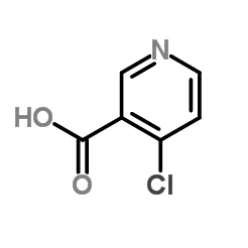4-Chloronicotinic acid, with the chemical formula C6H4ClNO2, is an organic compound that belongs to the class of pyridine derivatives. It is a significant intermediate in the synthesis of various pharmaceuticals and agrochemicals. SACH will share the intermediate 4-chloronicotinic acid for sale, which are crucial for understanding its behavior in different chemical processes and applications.
Molecular Structure and Geometry
4-Chloronicotinic acid features a pyridine ring, which is a six-membered aromatic ring containing four carbon atoms and two nitrogen atoms. The chlorine atom is attached to the fourth carbon of the pyridine ring. The molecular geometry of 4-chloronicotinic acid is planar due to the sp2 hybridization of the carbon and nitrogen atoms in the ring.
Melting Point
The melting point of a substance is a critical physical property that indicates the temperature range at which it transitions from a solid to a liquid state. For 4-chloronicotinic acid, the melting point is approximately 139-143 °C. This high melting point is attributed to the strong intermolecular forces, such as dipole-dipole interactions and π-π stacking, within the molecule.
Boiling Point
The boiling point of 4-chloronicotinic acid is not well-defined due to its tendency to decompose before reaching a boiling state. However, it is estimated to be above 300°C under normal atmospheric pressure. The high boiling point is consistent with the strong intermolecular forces present in the molecule.
Solubility
Solubility is a measure of how well a substance dissolves in a solvent. 4-Chloronicotinic acid exhibits moderate solubility in polar solvents such as water, ethanol, and methanol. The solubility in water at room temperature is relatively low, but it increases with temperature due to the increased kinetic energy of the molecules. The presence of the chlorine atom enhances the solubility in organic solvents, such as dichloromethane and acetone.
Density
Density is defined as the mass per unit volume of a substance. The density of 4-chloronicotinic acid is approximately 1.5±0.1 g/cm3. This value is higher than that of water, indicating that the compound is heavier and more compact at the molecular level.

Refractive Index
The refractive index of a substance is a measure of how much it bends or slows down light passing through it. 4-Chloronicotinic acid has a refractive index of around 1.59. This value is higher than that of water, reflecting the compound's ability to interact with light due to its polar nature and the presence of the chlorine atom.
Vapor Pressure
Vapor pressure is the pressure exerted by a vapor in equilibrium with its condensed phases at a given temperature. 4-Chloronicotinic acid has a low vapor pressure, which means that it does not readily evaporate at room temperature. This property is beneficial for its use in chemical processes where volatility is undesirable.
Thermal Stability
Thermal stability refers to the ability of a substance to withstand heat without undergoing decomposition or chemical change. 4-Chloronicotinic acid is thermally stable up to its melting point, after which it may decompose. This stability is important for its use in high-temperature chemical reactions and processes.
Optical Properties
4-Chloronicotinic acid, like many organic compounds, can exhibit optical properties such as UV-Vis absorption. The compound absorbs light in the ultraviolet region, which can be utilized in analytical techniques to determine its concentration in a sample.
Crystal Structure
The crystalline form of 4-chloronicotinic acid is characterized by its regular arrangement of molecules in a lattice. The crystal structure can influence the compound's physical properties, such as hardness, cleavage, and thermal conductivity.
Safety and Handling
Handling 4-chloronicotinic acid requires appropriate safety measures due to its potential irritancy and toxicity. It should be stored in a cool, dry place, away from heat and direct sunlight. Protective equipment, such as gloves and safety goggles, should be worn when handling the compound.
Applications
The physical properties of 4-chloronicotinic acid make it a valuable intermediate in the synthesis of various pharmaceuticals, including anti-inflammatory drugs and antibiotics. It is also used in the production of agrochemicals and dyes.
Conclusion
Understanding the physical properties of 4-chloronicotinic acid is essential for its effective use in chemical synthesis and other applications. Its high melting point, moderate solubility, and thermal stability are key characteristics that influence its behavior in various chemical processes. As research and development in the pharmaceutical and chemical industries continue, the role of 4-chloronicotinic acid is likely to expand, making it an increasingly important compound in these fields.
https://www.hzsqchem.com/Physical-properties-of-intermediate-4-chloronicotinic-acid.html
SACH
sales@hzsqchem.com
